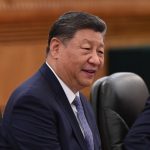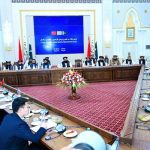Proposed Export Controls Signal Escalation in US-China Trade Tensions
The Trump administration is actively considering a comprehensive plan to restrict a wide range of software-powered exports to China, including products such as laptops and jet engines. This move is being evaluated as a direct response to Beijing’s recent expansion of export controls on rare earth elements, according to a U.S. official and three individuals briefed on the matter.
Although this proposal is one of several under review, it aligns with President Donald Trump’s earlier declaration to block “critical software” exports to China. The plan would target global shipments of items either embedded with U.S. software or manufactured using it, thereby extending U.S. export authority beyond domestic borders.
On October 10, President Trump announced via social media his intent to impose a 100% tariff on Chinese imports to the U.S. and implement new export restrictions on “any and all critical software” by November 1. However, sources caution that the measure, whose details are being publicly reported for the first time, may not ultimately be enacted.
Despite internal debate within the U.S. government—some officials advocating for a more measured approach—the consideration of such controls underscores the administration’s willingness to escalate its trade confrontation with China. “I will confirm that everything is on the table,” stated U.S. Treasury Secretary Scott Bessent during a White House press briefing. He added that any export controls, whether on software or other goods, would likely be coordinated with G7 allies.
Market Reaction and Expert Concerns Over Implementation
Following the Reuters report on the potential export restrictions, U.S. stock markets experienced a brief downturn. The S&P 500 closed 0.5% lower, while the Nasdaq dropped approximately 1% by the end of trading.
Emily Kilcrease, a former trade official now affiliated with the Center for a New American Security, noted that software represents a strategic leverage point for the United States. However, she warned that implementing such controls would be highly complex and could provoke significant backlash from U.S. industries. “You would hope they are only putting threats on the table that they would carry out and stick with,” Kilcrease remarked.
The White House and the Commerce Department, which oversees export regulations, declined to comment on the matter. Meanwhile, a spokesperson for the Chinese embassy refrained from addressing the specific U.S. proposals but criticized Washington’s “unilateral long-arm jurisdiction measures.” The spokesperson emphasized that China would “take resolute measures to protect its legitimate rights and interests” if the U.S. proceeds with what Beijing views as a misguided course of action.
Strategic Leverage or Diplomatic Pressure?
According to one source, the administration may announce the proposed export controls as a strategic maneuver to pressure China, without necessarily implementing them. Two other individuals indicated that narrower policy alternatives are also under discussion.
“The scope of this action is immense—everything imaginable is made with U.S. software,” one source emphasized, highlighting the potential global impact. The sources requested anonymity due to the sensitive nature of the deliberations.
If fully enacted, the measure could significantly disrupt global trade with China, particularly in the technology sector, and may carry economic repercussions for the United States. The proposal mirrors export restrictions imposed by the Biden administration on Russia following its 2022 invasion of Ukraine, which targeted items produced globally using U.S. technology or software.
President Trump’s announcement on Truth Social came just three weeks ahead of a scheduled meeting with Chinese President Xi Jinping in South Korea, and one day after China expanded its rare earth export controls. These elements are critical to the global tech manufacturing industry, and China currently dominates their supply chain.
Tariff Threats, Policy Reversals, and Upcoming Diplomatic Engagements
In his October 10 post, Trump accused China of planning “large scale Export Controls on virtually every product” it manufactures, including some foreign-made goods. He warned that such actions would impact all nations and labeled them “a moral disgrace.” However, ambiguity remains around what constitutes “critical software” under Trump’s proposed restrictions.
Since taking office, Trump has implemented a series of tariffs on Chinese imports but has shown inconsistency in applying export restrictions. For instance, he initially imposed strict curbs on shipments of Nvidia and AMD AI chips, only to later reverse those measures. Similarly, in May, the U.S. restricted exports of chip design software and other items in response to China’s rare earth shipment delays, but lifted those restrictions by early July.
China has also voiced opposition to a recent Trump administration rule that prohibits U.S. firms from exporting goods and technology to entities that are at least 50% owned by sanctioned Chinese companies. Currently, Chinese imports face U.S. tariffs of approximately 55%, which could surge to 155% if Trump follows through on his latest tariff threats. Nonetheless, Trump appeared to soften his stance in an October 12 post, stating, “The USA wants to help China, not hurt it!!!”.
Treasury Secretary Bessent is scheduled to meet with Chinese Vice Premier He Lifeng in Malaysia this week, ahead of the anticipated summit between Trump and Xi Jinping in South Korea later this month.














